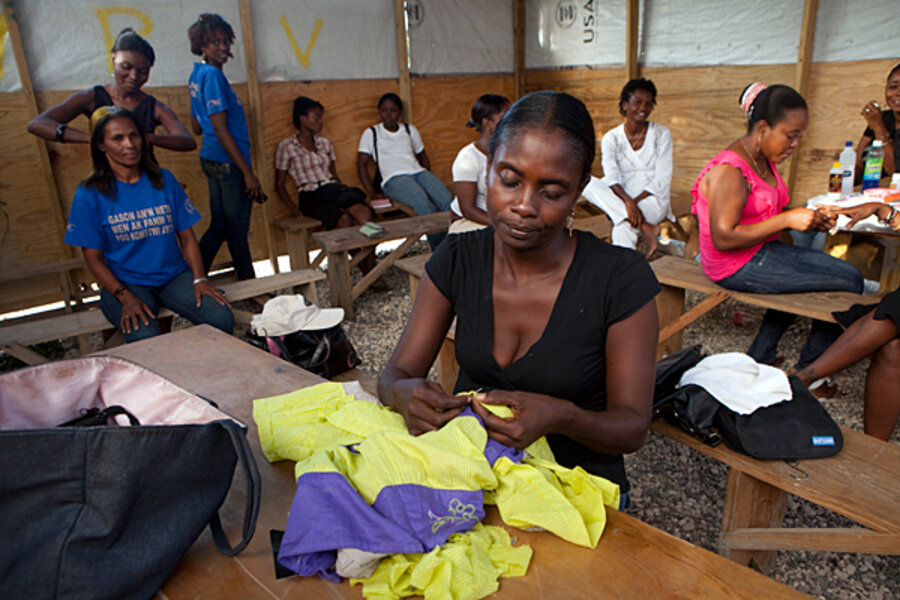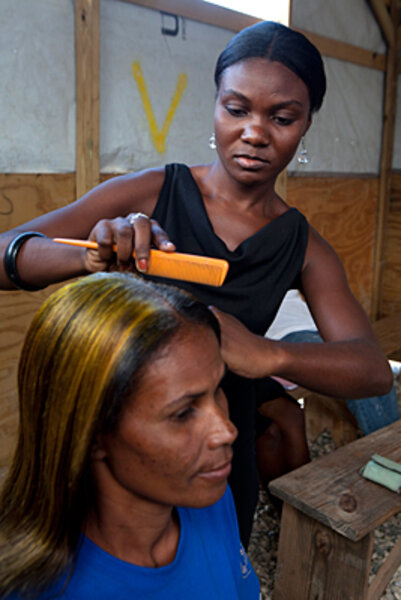How one program curtails the sex abuse that skyrocketed after Haiti earthquake
Loading...
| Port-au-Prince, Haiti
The women came first, gathering under a roofed plywood shack to learn basic skills that could help them get a job – to sew or speak English.
The meetings soon turned into a sort of group therapy, where they discussed the pressures of living in a squalid, crowded camp with 26,000 earthquake survivors.
But it wasn’t until their husbands joined them that the daily gatherings gave a few dozen Haitians a way to talk openly about sexual abuse – a problem that experts say has grown since last year’s earthquake.
IN PICTURES: Life in a tent city
“At first it was like 15 or 20 guys who came down to complain that their wives were spending too much time here,” says Franklin Fontaine, who has led the group meetings. “But then we all got together and sat down. … It was unbelievable, for many of them it was the first time they had ever said the words ‘domestic violence.’”
Amid a grim year of sexual violence that has plagued camps across Haiti, projects like this one, grounded in community involvement, have proved successful.
Even before a 7.0-magnitude earthquake devastated this impoverished Caribbean country one year ago today, Haiti struggled to protect women from rape and domestic violence. In the nearly two years after the 2004 coup that toppled President Jean-Bertrand Aristide, an average of 1,600 rapes were being committed every month, a study published in The Lancet medical journal found.
It has only worsened since the quake sent more than 1.5 million into unplanned camps, where an estimated 810,000 people still remain. With no running water and, in some cases, no lighting at night, women have been forced to bathe in public and make their way to latrines and showers in the dark. Even in their tents and huts, fashioned from flimsy sticks and tarps, they’ve been attacked.
'Nobody is being punished'
A report released Jan. 6 by Amnesty International found that sexual violence had grown dramatically since the earthquake struck and authorities were failing to stop it. The problem has persisted despite the presence of more than 12,000 police and military troops sent by the United Nations to Haiti to stabilize the country and years of warnings to the Haitian government.
“There’s no justice, nobody is being punished,” Gerardo Ducos, the report’s author, says.
Malya Villard-Apollon, a rape survivor and leader of KOFAVIV, a grassroots organization that works with victims, agreed. Working in 32 camps, her organization registered 859 cases since the earthquake. Only five cases have made it to trial and only one person – a police officer – has been jailed.
She says incidents of domestic violence have spiked in the last year. “We have cases in which young girls whose parents died in the earthquake were living by themselves in a camp and then moved in with a partner who began beating them,” she says through a translator. “Cases have definitely increased since the earthquake.” One of those girls was 10 years old when she was raped, Ms. Villard-Apollon says.
While much attention has been focused on random sexual violence, violence within the home is just as bad, if not worse, says Melanie Megevand, the protection coordinator for American Refugee Committee who started the program that brings women and their husbands together. Sixty percent of the cases her organization registered in the past year were victims of domestic violence and 40 percent were sexual violence cases.
COVER STORY: Year after Haiti earthquake, the state of global disaster relief
Talking leads to healing
Ms. Megevand says the camp program has been successful in raising the issue in homes where it was not previously discussed.
“Domestic violence existed long before the earthquake. … This allowed them to speak about the problem and to break the taboo,” she says.
The basis of the program was an adaptation of the successful child friendly spaces – in which an area in a refugee camp is set aside to allow children to play and study.
“It was good because we really didn’t know each other. We all came from different areas [to the camp.] So it allowed us to get to know each other,” says Ms. Zephayr Ylanne, who lost her home in the quake. “There was a lot of violence at the beginning, before this started. And we were all going through it or knew someone who was.”
That communal spirit, though, led to a backlash from some husbands. “At first, it was really hard. They’d gossip and make fun of us,” says Billy Villa, a woman who was learning to sew through the program.
But that turned to acceptance when the men “began to understand what this was about,” Ms. Villa says. “They liked being able to open up and talk about life here; talk about how hard it is to live like this.”
Program has 'been huge'
One of the husbands, who asked not to be identified, says his first experience wasn’t what he expected. “We had a good time. We could all talk about things we were all experiencing and we could laugh at them,” he says. “It helped with the stress.”
It also helped cut down on tension in the home, he says.
Ms. Megevand says that 20 men who were victims of sexual or domestic violence even came forward to report their case in the past year.
Although the program isn’t likely to solve Haiti’s overwhelming rape and domestic violence problems, it has served as an example for how communities can take control of the issue in their camps.
The American Refugee Committee has recently turned the program over to a local grassroots organization that is expanding it into new camps.
“For the people who participate, I think that it’s been huge,” Ms. Megevand says. “It allows them to transfer from victims to survivors.”






